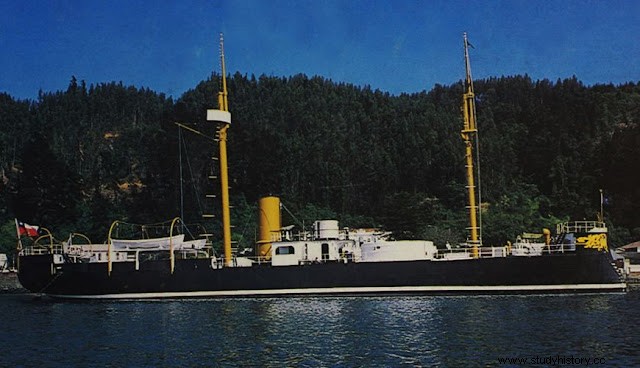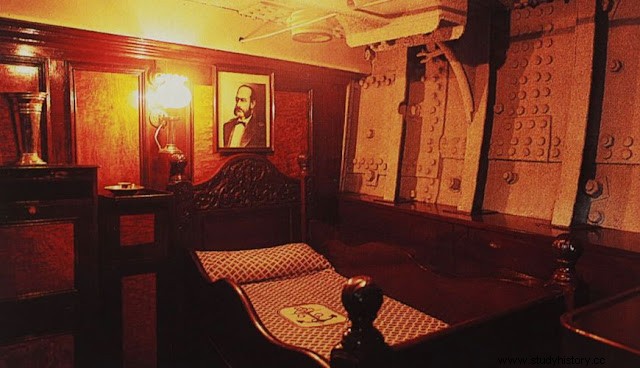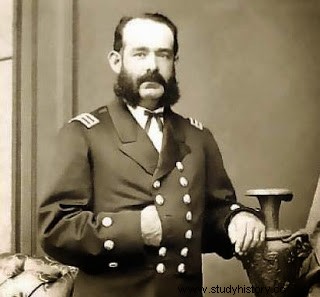Are you Peruvian? You come to see the Huáscar… your “ex” ship. There is curiosity, and a certain mockery in the Chilean sailor who accompanies me to Bahía Concepción. I moved forward in silence remembering distant school lessons on the history of Peru. "You will be surprised by how young he is." The warning was common in Santiago during the efforts to visit the legendary monitor, the ship of the exploits in the War of the Pacific, the place where Miguel Grau fell to pieces. At the Talcahuano Naval Base, the Chilean sailor's question hardly distracts me from that quick review of basic history classes.-Yes, I'm Peruvian. I said proudly. We walked together for a while. The Huáscar was only a few meters away, painted black, with a white deck and yellow masts. We remember the warning. She is small for these times, but her 67 meters long and 11 wide, made her a fearsome ship at the end of the last century. Nobody back then could imagine it, a century later, as an inoffensive floating museum, in Chile's Second Naval Zone. which, depending on the nationality of the visitor, mixes up tourist curiosity, Chilean pride and silent reverence. The museum was inaugurated on October 8, 1952. The idea was the work of Rear Admiral Pedro Espina. The ship had remained anchored in the Talcahuano arsenal since 1930. That year she was relieved of official service as mother ship of the first flotilla of Chilean submarines.
 Talcahuano Naval Base where the Huáscar monitor is anchored. It was her second and definitive goodbye. In 1901 it was disabled for several years, following the bursting of a steam pipe that caused the death of 14 sailors. Despite its 131 years, its conservation is admirable. Nobody could detect or repair that the Huáscar was pierced by 76 cannon shots in the Combat of Angamos. The conservation work on the hull, cabins and engine rooms deserved recognition for the Chilean navy:on October 27, 1994 they received the World Ship Trust award. A distinction that the English institution grants to historic and ancient ships. which are kept in excellent condition.
Talcahuano Naval Base where the Huáscar monitor is anchored. It was her second and definitive goodbye. In 1901 it was disabled for several years, following the bursting of a steam pipe that caused the death of 14 sailors. Despite its 131 years, its conservation is admirable. Nobody could detect or repair that the Huáscar was pierced by 76 cannon shots in the Combat of Angamos. The conservation work on the hull, cabins and engine rooms deserved recognition for the Chilean navy:on October 27, 1994 they received the World Ship Trust award. A distinction that the English institution grants to historic and ancient ships. which are kept in excellent condition.Every month a team of divers checks the hull. Mariners examine the structure of the monitor and provide sophisticated maintenance. A contingent of six sailors, under the command of Commander Vicente Fontaine and Sergeant Pedro Jaque Vera, has the mission of keeping watch over the Huáscar. Over the years, the stories of ghosts and souls that grieve restlessly on the deck or in the holds of the ship. "That is part of the past," says Sergeant Jaque Vera. “Although some nights I feel stares nailed to my back.”
Every October 8, while the traditional tribute to Miguel Grau and the heroes of Angamos is paid in Peru, the monitor is visited by future NCOs who swear on your deck. That date is known in Chile as the day of the Suboficial Mayor. There is no sign of pettiness or triumphalism. In memory of Grau, Chileans place floral offerings. The Peruvian consul attends the ceremony. But there are also other anniversaries that are remembered here. For May 21 (date of the Battle of Iquique, where Arturo Prat, the greatest hero of the Chilean navy, died), lights are placed throughout the deck. The same happens on National Holidays (September 18) and New Year.
There was war with Peru!
One can visit Huáscar wherever she wants. No set route. The influx of public causes long queues to enter the Naval Base. The agglomeration is similar to getting on the floating platform that leads to the ship. On the white deck, as throughout the tour, a recording from the loudspeakers recalls the war actions, accompanied by military marches in the background. At different points of the On the deck, three monoliths mark the place where Miguel Grau, Arturo Prat and Manuel Thomson, the commander of the monitor who assumed command when the ship passed into the hands of Chile, perished. Some red spots on the Torre de Coles indicate the impacts received in combat. The control tower, where Grau died in pieces, looks rebuilt. Visitors weave unique dialogues on their tour. From the usual admiration, to the eloquent surprise at hearing that Chile and Peru were once in a war.
-There was a war with Peru!, a Uruguayan tourist is scandalized.Of course!, replies her companion.- When?-Last century.-Why?-For some land.-I'm going to have to read...
The number of visitors motivates frequent encounters in the passageways and allows more dialogue to be heard.
- Dad, did we win the war?-Of course my son.-And do the good guys always win?-Of course, the good guys always win.-You mean that we Chileans are good guys.-Of course.-And if one day we lose?
“Honor and pride”
Nobody has erased the inscription that stands out on the stern rudder. “The honest, loyal and brave man inspires honor and pride in his compatriots. The traitor and coward is the disgrace and dishonor of his homeland ” .
Thus, under that motto, the sailors of the monitor lived and died. That is why the recognition and respect of the Chileans. "We know how much blood and sacrifice there is on this ship -acknowledges Sergeant Jaque-. There was Peruvian and Chilean heroism. That can never be forgotten”. In the tour of the five main rooms, the care to maintain the ship in its original state is evident. In the general crew chamber there is still the original table where food was served and even the hooks that held the hammocks in the hours of rest. The breadth of this room has allowed the installation of oil paintings alluding to various combats that Peruvians and Chileans sustained in the War of the Pacific. There are also scale replicas of the Huáscar and the Esmeralda, the ship in which Prat perished. One of the walls shows the world the military orders that Grau received on May 15, 1879. The signature of Don Domingo del Solar. There is another environment that corresponds to Coles Tower, with its two heavy cannons. The walls have been covered with a special cork that prevents corrosion and humidity.
 The cabin of the hero, Miguel Grau. There, in each combat, sixteen men operated the tower, turning it from one side to the other to launch an attack. The old boiler, where coal was stored, is now an altar. There, every May 20, a mass is celebrated in memory of the victims of the Battle of Iquique. The portrait of Arturo Prat stands out next to a cross. The environment is littered with oil paintings by Chilean sailors. In the center, a glass case holds what was supposed to be the Peruvian pavilion, lowered from the mast of the Huáscar after the Battle of Angamos. On the way to what was the grand admiral's cabin, we find another dining room, that of the officers, surrounded by their bedrooms. The table, for 14 people, the same number of cabins for officers that the Huáscar has, is neatly preserved and is the previous step to the stern, where Grau spent the last night of his life.
The cabin of the hero, Miguel Grau. There, in each combat, sixteen men operated the tower, turning it from one side to the other to launch an attack. The old boiler, where coal was stored, is now an altar. There, every May 20, a mass is celebrated in memory of the victims of the Battle of Iquique. The portrait of Arturo Prat stands out next to a cross. The environment is littered with oil paintings by Chilean sailors. In the center, a glass case holds what was supposed to be the Peruvian pavilion, lowered from the mast of the Huáscar after the Battle of Angamos. On the way to what was the grand admiral's cabin, we find another dining room, that of the officers, surrounded by their bedrooms. The table, for 14 people, the same number of cabins for officers that the Huáscar has, is neatly preserved and is the previous step to the stern, where Grau spent the last night of his life.Was Grau flat?
Grau's cabin is being repaired. All layers of paint have been removed to restore the original color of the wood. The color of mahogany is sprouting again after a century. The environment, closed for tourists, was opened for us. It was an unexpected, unforgettable and -why hide it- emotional encounter with our history. The piece consists of two environments. First there is the reception room which was the meeting place with the officers. From a huge oil painting hanging on one of the walls, Grau seems to prolong in time the formidable command he had over his ship.

“Peruvian Commander Miguel Grau, hero and knight who died in the Battle of Angamos…”, reads on a plaque, placed there by Chilean sailors. At the end of the room is his cabin. The entrance reveals a desk where the letter that Grau sent to Prat's widow after the Battle of Iquique is displayed behind glass. The sign of his chivalry.
The bed, surprisingly small, is covered by a blue bedspread where the drawing of an anchor stands out. A compass hanging from the ceiling reminds us that it is the commander's room. Was Grau so young? Or have they done some remodeling of the cabin, we asked the diligent Jaque. “Grau was short. He was no more than one meter 60. It was the frame of the time.” We took two more walks through the Huáscar. Breathing every corner again, feeling that a key episode -painful, indelible and definitive- of our history is floating in Talcahuano.
Published in the Sunday Supplement, Diario La República, 1996.
